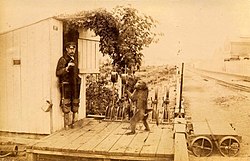Biography
Jack was the pet and assistant of double leg amputee signalman James Wide, who worked for the Cape Town–Port Elizabeth Railway service. James "Jumper" Wide had been known for jumping between railcars until an accident where he fell and lost both of his legs below the knee. [2] To assist in performing his duties, Wide purchased Jack in 1881, and trained him to push his wheelchair and to operate the railways signals under supervision.
An official investigation was initiated after someone reported that a baboon was observed changing railway signals at Uitenhage near Port Elizabeth.
After initial skepticism, the railway decided to officially employ Jack once his job competency was verified. He was paid twenty cents a day, and half a bottle of beer each week. It is widely reported that in his nine years of employment with the railway company, Jack never made a single mistake. [5]
Jack died of tuberculosis in 1890. His skull is in the collection of the Albany Museum in Grahamstown.
According to a letter published in Nature , Jack
acted as a railway-man at Uitenhage in the Cape... The story was documented originally by the Rev. George Howe, in 1890, and then by F. W. Fitzsimons, director of the Port Elizabeth Museum. Fitzsimons' account... is published in the Cape Mercury of 29 May 1923. It relies on an interview with Wide, the written statements of 25 witnesses, filed in the museum collection, and on Howe's evidence. [6]
This page is based on this
Wikipedia article Text is available under the
CC BY-SA 4.0 license; additional terms may apply.
Images, videos and audio are available under their respective licenses.
